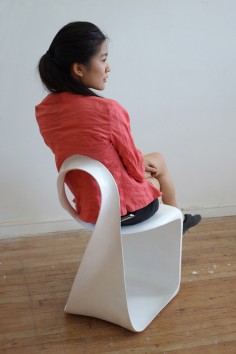takeshi miyakawa
宫川武
Такеши Миякава
mobius chair

source: is-arquitecturaes
El diseño de la Silla Mobius no es reciente. Su creador llevaba desde el 2010 trabajando en la idea de fabricar un mueble que estuviera formado por una única superficie curva. Primero la materializó en maquetas de tela metálica, fibra de vidrio, y resina,… pero la ocupación de otros proyectos hizo que el concepto quedara apartado durante un tiempo en un rincón de su estudio.
El diseño volvió a cobrar vida gracias al interés del director de una galería de arte de Nueva York, por lo que pasó por un proceso de renovación, en el que se ajustaron curvas, se lijaron superficies, y se escogieron los materiales definitivos que garantizaran una capacidad de carga apropiada para la silla. La Silla Mobius finalmente adquirió la forma de una cinta blanca cerrada* (anillo) que gira sobre sí misma, para crear el apoyo, asiento, y respaldo. Es precisamente el respaldo la parte de su diseño que creemos debería mejorarse, para ofrecer más superficie de contacto al usuario, porque tal como está ahora podría lastimar la espalda.
.
.
.
.
.
.
.
source: spoon-tamago
Ever since German mathematician August Ferdinand Möbius identified the Mobius strip, its non-orientable property has presented itself as a muse for artists, architects and designers. From exhibitions to residential homes, the curious properties of the band has puzzled and inspired. But in it’s latest iteration, Brooklyn-based Japanese designer Takeshi Miyakawa has created “Mobius chair,” a seat made from a single, continuous band.
“I designed this Mobius chair about 5 years ago and made a rough mockup using chicken wire, fiber glass and aqua resin,” says Miyakawa. But the chair never became a reality. Life got in the way and the Mobius Chair was forgotten about, until just a few months ago when it was unearthed by a curator who was visiting Miyakawa’s studio.
“She found this dusty mockup and asked me if I could finish it for the show,” says Miyakawa, whose chair is currently on display (through August 1, 2014) at Salon 94. “In order to adjust curves, I had to continue sanding and adding more materials for a few weeks and finally I got it right.”
.
.
.
.
.
.
.
source: designboom
brooklyn designer takeshi miyakawa is showing ‘mobius chair’ as a part of the group show, ‘more materials’ curated by duro olowu at salon 94. ‘I designed this chair about five years ago and made a rough mockup using chicken wire, fiber glass and aqua resin but I got busy on other projects so I never finished it and it was left at the corner of my studio,’ miyakawa said. the design was brought back to life when a director from the new-york based gallery noticed it occupying a forgotten space in the artist’s office. after her request that he complete the work, the curves were adjusted, specific areas were sanded down, and materials were added to maximize its carrying capacity. the final product is a white, ribbon-like shape whose form rotates around itself. from the straight on, it appears as a soft edged cube articulated by the front leg, seat, and base, while the back spirals upwards and downwards to project a different visuals of light and shadow when viewed from every angle.
.
.
.
.
.
.
.
source: tevami
Takeshi Miyakawa is a Japanese designer that originates from the heart of Japan, Tokyo,, where he was born and raised in 1962. In 1985 he graduated from the Tokyo Science University with a degree in architecture and went onto work for the Tokyo Construction Corporation as a site supervisor, where he worked for 4 years until moving to New York City in 1989. The next year would be a turning point in his life when he found his love for furniture, working for Stephan Rohner Furniture in Brooklyn and then Rafael Vinoly Architect. 2001 was his big break though, when he founded Takeshi Miyakawa Design, which is steadily churning out the beautiful designs.
.
.
.
.
.
.
.
source: artpartorg
Мастерская японского дизайнера Такеши Миякава (Takeshi Miyakawa) — это целый мир, состоящий из множества оригинальных предметов, сделанных вручную из бумаги, картона, пенопласта и фанеры. Исключительно при помощи рук и своих тактильных навыков Миякава воплощает свои креативные идеи: от прототипа на бумаге до практического изготовления предметов. Простота геометрических форм, весёлый практичный дизайн — вот основные постулаты его работы.
Дизайнер проникся искусством хенд-мейд ещё в 5 лет, когда отец научил его делать из стеблей бамбука игрушечные самолёты.
Такеши Миякава окончил Токийский университет науки по специальности «архитектура», после чего в течение 4-х лет работал супервайзером по строительству. В 1989 году он переехал в Нью-Йорк и стал модельщиком архитектурных деталей в компании Rafael Viñoly Architects, основанной известным уругвайским архитектором Рафаэлем Виньоли.
В 2001 году Такеши Миякава открыл свою собственную фирму и в настоящее время активно участвует в различных дизайнерских конкурсах и фестивалях. Большое внимание в своей работе Миякава уделяет разработке стильных предметов интерьера, призванных максимально выгодно использовать пространство японских квартир и домов, где каждый сантиметр — на вес золота.
.
.
.
.
.
.
.
source: massiveideaswordpress
Formado em arquitetura na Universidade de Ciências de Tokio, trabalhou como supervisor de construção durante quatro anos. Período no qual ficou em contato com artesãos de altíssimo nível e aprendeu diversos processos de construção.
Em 1989 fixou residência em Nova York e um ano e meio mais tarde começou a trabalhar com Stephan Rohner e Haruo Sato da “Rohner Furniture”, que infelizmente fechou as portas devido à recessão da economia.
Pouco depois, ele começou na “Rafael Vinoly” como o cara da maquete. Como o Sr. Vinoly sabia bem da importância de um modelo físico como ferramenta de desenho as habilidades de Takeshi eram requisitadas com frequência.
Após 8 anos do intenso trabalho com maquetes, ele fundou “Takeshi Miyakawa Design” em 2001.

